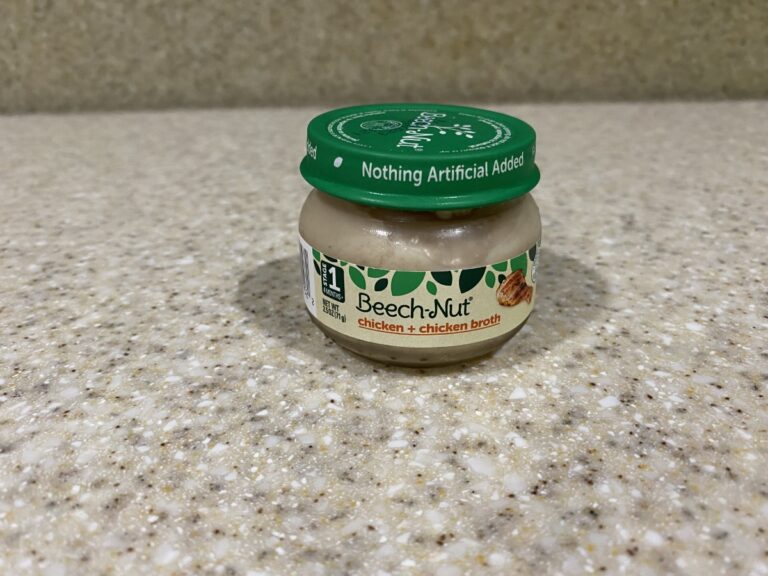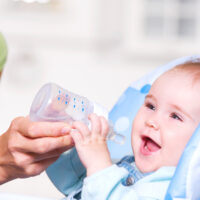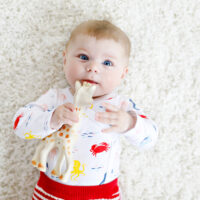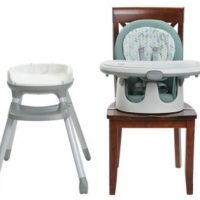When it comes to baby food, I have one rule: if I wouldn’t eat it, I’m not serving it to my baby. With so many shelves of packaged baby foods available, you may wonder which is the best food for your baby. The best baby food is free of any added sugars, salt, and artificial flavorings or colors (source). It only provides “the good stuff ” for your little one. My research shows that these are the best baby food options currently on the market.
While baby food pouches are definitely convenient, younger infants may need parental assistance. The American Academy of Pediatrics recommends introducing first foods between four to six months old (source). Per these and World Health Organization’s recommendations, some mothers exclusively breastfeed until age six months. Infants then start with single foods. Since most pouches contain blends of more than one fruit or vegetable, they may not be appropriate until a baby is older.
Whether or not to start foods will also depend on your infant’s readiness. In order to tolerate pureed foods, babies must master holding their head up without assistance, and be able to sit upright with the support of a high chair or infant seat. Some four-month-olds readily accept spoon-feeding, while other infants are not ready until one or two months later.
By six months, most infants can grab and hold onto objects, then learn to transfer them from one hand to another (source). However, holding a pouch and squeezing it in a way to get food into the mouth may be difficult at this age. It is, therefore, better to add the pouch contents to a bowl, and feed with a spoon. Older infants and toddlers, however, should have the developmental skills to use food pouches with ease.
Best Baby Food Pouches
Gerber Organic 2nd Foods Pouches has a variety pack of 18 pouches with 3 flavor combos of mixed fruits and vegetables, while Happy Baby Organics Baby Food Pouches come in a variety pack of 10 pouches with 10 different flavor combinations of veggies and fruits.
Pumpkin Tree Peter Rabbit Organics
The Pumpkin Tree Peter Rabbit Organics is a wonderful choice because there are a variety of options you can choose as your baby grows. From that first bite through toddlerhood, you can find a Pumpkin Tree Peter Rabbit flavor that is sure to satisfy.
Firstly, these baby foods are BPA-free and gluten-free for the highest quality and to avoid allergens. The pouches are made with organic fruits, vegetables, and other ingredients. The products are simple, wholesome, and none are diluted with water so your children get more nutrients.
Secondly, the ingredients are organic and non-GMO. There are no additives or preservatives, and the foods are free of dairy, wheat, and soy to help little ones with allergies.
Once the pouches are opened you need to refrigerate and use them within two days. You’d be fine to throw one in your diaper bag for use in an hour or two, but they should stay refrigerated as long as possible once opened. Babies will love the flavor mixes and all the options.
Each kit comes with 10 pouches, 4.4 ounces each. You’ll get dozens of great flavor blends but for fruits they have:
- Apple and Grape
- Apple and Peach
- Apple, Carrot, and Pumpkin
- Mango, Banana, and Orange
- Strawberry and Banana
- Raspberry, Banana, and Blueberry
- Plus more options with veggies!
Because these pouches contain food blends, it is safer to offer them after your baby has tried and tolerated each food individually. If your infant has had an allergic reaction to a particular fruit or vegetable, you should avoid pouches that have this particular ingredient.
Finally, compared to other products, this kit is expensive. It’s also better for babies who have moved on to stage 2 foods or more advanced textures (source). Think of the Peter Rabbit baby food as being the exact same thing as homemade baby food, except you didn’t have to make it yourself!
Happy Baby Organics Clearly Crafted Baby Food
The hardest part about giving your baby Happy Baby Organic Clearly Crafted pouches is choosing which one they like the best. There are so many options!
I love the variety of flavors Happy Baby offers. Here’s what you will find in your box:
- Apples, Blueberries & Oats
- Pears, Squash, Blackberries
- Apples, Guavas & Beets
- Bananas, Raspberries & Oats
- Apples, Pumpkin & Carrots
- Sweet Potatoes, Mangos & Carrots
- Green Beans, Spinach & Pears
- Apples, Kale & Avocados
- Bananas, Pineapple, Avocado & Granola
- Pears, Kale & Spinach
The variety pack has 10 pouches, 1 of each type. However, what you receive may vary with availability and seasonality.
The pouches contain no added sugars, artificial flavoring, or colors. In addition, hormones, GMOs, or pesticides are not used in their products. The packaging is also BPA-free.
The Happy Baby pouches are perfect for older infants and toddlers. However, the company does offer single fruit or vegetable jars for those who are just starting first foods. The pouches are resealable, and while the pouch itself isn’t recyclable, the cap is.
If your baby doesn’t finish the pouch in one sitting, you can easily refrigerate the leftovers for up to 24 hours. Beyond that, you should discard it.
The only downside of the Happy Baby pouches is their price. Expect to pay over $2 per pouch. That said, you are getting a quality, organic product for your own little happy baby.
Gerber Organic 2nd Foods Baby Food
Gerber has a long-standing reputation, and their products are trusted by many parents. This includes their Gerber Organic 2nd Foods, which offers 3 varieties of fruit and vegetable combinations.
I personally have a difficult time getting my kids to eat vegetables, so I have always loved when a healthy green can be concealed by a sweet fruit.
Firstly, I’m a huge fan of pouches. They are super-convenient, and there is nothing to clean! The Gerber pouches have a unique, smart flow top that insures only an appropriate amount of food comes out with each sip. No more baby squirting food all over your car!
Secondly, the tops are soft and rounded, much gentler on your baby’s mouth. I really appreciate this feature. Teething babies chew on everything, and the last thing you need is a cut in the mouth from their pouch top. I speak from experience on this one!
The variety pack has 18 pouches, each with 3.5 ounces of pureed food. The included flavors are:
- Apple, Blueberry, Spinach
- Carrot, Apple, Mango
- Pear, Peach, Strawberry
What’s also great about the Gerber Organic foods is that they are made with only fruits and vegetables. This means no artificial flavors or sweeteners.
The only thing added to some pouches is organic lemon juice or ascorbic acid, to preserve freshness and color.
Another nice feature is that the clear packaging allows you to inspect for mold before offering it to your baby. This prevents you from accidentally giving your baby a bad batch. Always check the expiration date before giving any pouch to your little one.
Plum Organics Stage 2 Baby Food
Babies nine months and up can enjoy one of the Plum Organics Stage 2 pouches. With Plum Organics, you can trust that you are giving your baby only the best quality ingredients.
The foods are all non-GMO, unsalted, unsweetened, organic, and kosher. The only additions are organic lemon juice concentrate and citric acid as a natural preservative. There are no added sugars in these pouches.
The Plum Organics variety pack comes with 18 pouches, 4 ounces each. Examples of flavors include:
- Apple & Broccoli
- Peach, Banana & Apricot
- Apple & Carrot
What I like most is that the label indicates how much of each fruit and veggie your baby receives with each serving. For example, the apple and carrot pouch is approximately 1/2 an apple and 3/4 of a carrot.
Some pouches have added fiber which helps prevent constipation.
In addition, these pouches are resealable which helps to reduce food waste. They are BPA-free, and, while the pouch itself isn’t recyclable, the caps are. This is just a little step to help our planet.
Earth’s Best Organic Stage 2 Baby Food
Earth’s Best Organic Stage 2 Baby Food has lots of variety, including vegetable and fruit blends. For older infants, they even offer full casserole dinner flavors!
Each box contains 12 pouches, 3.5 ounces each. Each one pouch is the perfect size for the appetite of an older infant, or can be 2 meals for a younger baby. Some of the best flavors include:
- Carrots and Broccoli
- Squash and Peas
- Sweet Potato and Beets
- Banana Blueberry
- Orange and Banana
- Pumpkin, Cranberry, and Apple
There are fun flavors such as Cheesy Pasta and Veggies and Chicken Casserole with Veggies and Rice! Earth’s Best baby food pouches only come in stage 2 and 3 textures. For younger infants, they offered jarred single food options.
Regardless of the flavor or food stage, each and every pouch is organic and non-GMO. There are no added colors, flavors, preservatives, sugars, salts, or other undesirable ingredients. They only contain fruits, veggies, and a little water for the right consistency.
The pouches are BPA-free and resealable. If your baby is unable to eat a whole pouch, it is best to squeeze the puree into a bowl, and feed with a spoon. This prevents product contamination with bacteria. These pouches only need to be refrigerated after opening, and should be consumed within 24 hours.
Earth’s Best pouches run about upper-to-middle of the market on price. They are one of the more affordable organic options. If you like to save money, like me, check your local grocery store for sales and coupons. It may also be more cost-saving to purchase them in bulk on Amazon.
Serenity Kids Baby Food Meat Variety Pack
The Serenity Kids Baby Food Ethically-Sourced Meat Variety Pack is a great way to introduce your little one to proteins.
Although vegetable-only pouches are available, this company seems to focus on providing more palatable fish, meat and poultry baby foods. They have traditional chicken and turkey meals, but also ones with salmon, beef and bison. The variety pack includes 8 pouches total, 2 of each flavor, with each pouch containing 3.5 ounces.
Also, because most parents don’t want to feed their baby something that resembles cat food, the proteins are blended with healthy vegetables, making them more acceptable to developing palates. Ingredients like sweet potatoes and avocado oil give a better texture and flavor.
These purees have no artificial flavors, colors, or added salt. The meats are all ethically sourced and pasture-raised on small farms in the USA. The added vegetables and oils are all certified organic.
In addition to the 5 grams of protein, each pouch is a good source of potassium and healthy monounsaturated fats, important for your baby’s development and growth (source). Each pouch also provides at least 30% of a baby’s daily value of zinc.
The shelf life of this packaged baby food is about 18 months, and they do not require refrigeration prior to opening. Once opened, make sure you refrigerate any leftovers, and use them within 24 hours. To prevent bacteria growth in the uneaten portion, do not feed your baby directly from the pouch. Instead, squeeze the food onto a spoon or into a bowl.
As a bonus, the pouches are completely recyclable through TerraCycle. This is a plus for the environment and prevents a multitude of pouches from ending up in landfills.
One downside to Serenity Kids Pouches is the price. Although other brands may be cheaper, you are paying for a quality product. Hormone-free, antibiotic-free, grass-fed, pasture-raised meat and poultry for your baby is worth it!
Mama Bear Organic Baby Food
Mama Bear Organic Baby Food is Amazon’s own brand of organic baby food. The pouches are designed for babies who are ready for stage 2 foods.
These pouches offer only “the good stuff ,” and keep everything unnecessary out. The ingredients are non-GMO, and there is no added salt, or artificial colors or flavorings.
The 12 pack has a variety of options!
- Apple
- Apple Banana
- Apple Banana Strawberry Yogurt
- Apple Carrot Apricot Millet
- Apple Peach Banana Yogurt
- Apple Pear Green Pea
- Apple Pear Spinach
- Apple Sweet Potato
- Mango Apple Carrot Peach
- Pear
- Pear Apple Broccoli
- Pumpkin Apple Peach Buckwheat
Clearly, apple is the dominant ingredient in almost all of their pouches. Each one contains 4 ounces of goodness. Only lemon juice concentrate and ascorbic acid are added to maintain color and freshness.
I find Mama Bear pouches to be more affordable than other products on our list. In some cases, they are nearly half the price! However, the packaging isn’t as durable as some of the others, so pack them carefully inside your diaper bag.
Sprout Organic Baby Food Pouches
The Sprout Organic Baby Food Pouches provide the perfect opportunity to discover your baby’s food preferences.
For a variety of flavors, look no further. This pack of 12 comes with, you guessed it, 12 different options.
Here’s a list of everything that is included:
- Spinach Banana Apple
- Sweet Potato White Beans
- Apple Oatmeal Raisin
- Mixed Berry Oatmeal
- Carrot Apple Mango
- Carrot Chickpeas Zucchini Pear
- Strawberry Pear Banana
- Butternut Blueberry Apple with Beans
- Blueberry Banana Oatmeal
- Apple Banana Butternut Squash
While it may seem like a flavor overload, it allows you to test your baby’s palate.
These baby foods are made with certified organic, non-GMO ingredients. In addition, you won’t find preservatives or concentrates in these BPA-free pouches.
These products differ from others on the market by including plant-based proteins such as white beans and chickpeas. I, personally, am always on the quest for ways to incorporate protein into my kids’ meals. I think it’s ideal that the Sprout pouches offer these additional nutrients.
My only complaint about these tasty pouches is the price. Prepare to spend just over $2 per pouch.
The company offers Sprout Organic pouches for a range of ages, beginning at 6 months ready to progress from stage 1 foods.
Best Baby Food Snacks
Gerber Puffs are the perfect first finger foods that include grains, vitamins, and minerals; whereas the Happy Baby Organics Yogis Yogurt Snacks are the next step after Gerber Puffs and include probiotics which helps with gut health.
Baby Mum-Mum Rice Rusks
Hot-Kid Baby Mum-Mum Rice Rusks Variety PackAround seven months old, infants begin to use their fingers instead of the whole hand to pick up objects. By the first birthday, they are able to grasp using only their thumb and index finger. Snacks are a great way for infants to hone this skill (source). The Baby Mum-Mum Rice Rusks a type of teething biscuit, is a fabulous snack for this purpose!
These rice rusk biscuits are little crisp sweet cookies that dissolve in baby’s mouth. Giving one of these to your baby is a great way to teach self-feeding, and also alleviate sore gums. The biscuits mash up quickly inside the mouth, so they do not become a choking hazard.
The Baby Mum Mums are available in several flavors. They are free of gluten, dairy, nuts, soy, and just about any other major allergen.
Many parents are shocked to find organic sugar and sea salt on the ingredient list. Added sugar is discouraged at this age, and can create a preference for sweet tastes (source). The Apple and Pumpkin flavor doesn’t have the added sugar and salt, so it’s a better option.
Gerber Puffs Cereal Snack
Gerber Puffs are a classic rite-of-passage for any baby who is ready for finger foods. These puffs provide both a snack and a way to practice finger feeding.
They are sold in a variety pack, featuring 4 of the two best flavors: banana and strawberry with apple. Both types of puffs have a few essential vitamins and minerals. Only whole grains are used which adds fiber to the snacks.
These snacks are just the right size and shape for little fingers to grasp. They also dissolve quickly inside of the mouth, meaning they are less of a choking hazard. Although there is a small amount of added sugar, they’re a great first solid snack food.
Happy Baby Yogis Organic Yogurt Snacks
Once baby has mastered cereal puffs, the Happy Baby Organic Yogis Snacks are a great next step. These freeze-dried fruit and yogurt snacks are tasty and melt quickly. Many parents introduce yogurt into their infant’s diet by ages six to nine months, so these puffs would be appropriate to offer at that time.
First, you’ll love that these puffs contain probiotics, a la baby yogurt,to aid digestion, and promote immunity and gut health. Adding probiotics can be a great idea when baby starts to eat solid foods as it can ease their tummy, and help prevent constipation (source). These snacks are fortified with two different probiotic strands.
Second, you’ll love the flavors! The variety pack contains strawberry, mixed berry, and banana & mango flavors. The combination of organic milk and fruit purees with just a pinch of organic sugar really is tasty.
Third, these snacks are a source of protein. Since these are intended for crawling babies, that extra protein is great for growing and developing muscles.
I promise that your baby will love these, just as mine did. These make a great “appetizer” when baby is hungry and impatient in a high chair as you prepare the main course.
Also, check out the Happy Baby Coconut Creamies which are dairy-free! These versions, however, are similar to standard puffs, and do not contain probiotics or a protein source.
Best Baby Food Cereal
Happy Baby Whole Grain Oatmeal
The Happy Baby Oatmeal is the only whole grain on our list, but rightfully so. This product contains whole grain organic oats and iron for brain development (source). Vitamin C is included to assist with iron absorption.
This cereal comes in a 7-ounce package, and is free of the top 8 allergens, including gluten. It easily mixes with breastmilk, formula, or water.
In addition, this oatmeal is a perfect first food for four to six month old infants who are able to hold their heads up well, and are beginning to sit up.
If you feel your baby is not loving the plain version, try mixing in a fruit, vegetable, or nutbutter. Just make sure the added food is one they’ve tried previously, and that there has been no allergic reaction.
Looking closely at the nutrition label, there is 1 gram of added sugar. I did a little digging to figure out why. Here is the answer, mamas:
When cereal is manufactured, an enzyme to helps process the grain flour into a liquid. This allows the cereal to be made into the flakes you find inside your cereal box, for example. This process breaks down the starches into simple sugar which becomes the source of the “added sugar.” While it sounds super confusing, it is reassuring to know that it’s not just added refined sugar, just a natural part of the processing.
One thing to note: this is a whole grain oatmeal. Don’t be surprised if you notice a unique, earthly smell.
Best Baby Food Jars
Gerber Baby Food Purees 2nd Foods Variety Pack
The Gerber Purees 2nd Foods is a great way to introduce a variety of fruits and vegetables to your baby. When your infant is developmentally ready for first foods, you can give any of these flavors a try.
The box has 16 double packs (32 individual servings), and each serving is 4 ounces. Here’s a list of what’s in the variety pack:
Fruits
- 2 Apple
- 2 Apple Strawberry Banana
- 2 Apple Blueberry
- 3 Banana
Vegetables
- 2 Sweet Potato
- 1 Green Bean
- 2 Butternut Squash
- 1 Carrot
Each container has no added sugar, salt, starch, or artificial flavors or colors. Some have added water to improve the texture. Ascorbic acid or lemon juice concentrate are used to maintain the food’s color and ensure freshness.
The entire package is recyclable which is good for the environment.
If your baby is unable to eat a whole serving, it is best to add a portion to a bowl rather than feeding from the jar. This prevents bacterial contamination of the remaining food. Think of it as “double-dipping.” This can increase the risk of your baby developing food poisoning.
Any uneaten food left in the container can be refrigerated for up to two days.
Baby Food Buying Criteria
With all of the above selections, I carefully examined the ingredients to determine what made it one of the best baby foods to give to your little one. As a mother of three, I truly want to know what my kids are eating.
Several aspects were considered in the selection process. Here are the criteria I used to make my recommendations.
Ingredients
Baby food ingredients are the most important aspect to consider. When you pick up a jar or pouch of baby food, the ingredients list is what you should review first.
Sometimes in life, “extra” is a good thing, but not in regards to the best baby food. When I read labels, I don’t want to see “extra” ingredients like preservatives or artificial flavorings. I only want to see “the good stuff.”
Exceptions to this rule are natural preservatives such as lemon juice or ascorbic acid (a.k.a. Vitamin C) which is derived from citrus fruits (source). I avoid any baby foods that include artificial colors or added sugars in their ingredients.
The best baby food on the market gives you exactly what you want, and nothing else.
Another way I approach an ingredient list is, if I can’t pronounce something, I’m not giving it to my child. This doesn’t mean that my kids eat only natural and organic foods. It just means that I try to avoid unnecessary ingredients, especially in baby food.
The best baby food only has the most pure ingredients.
Price
There is no doubt that having a baby increases your household’s expenses. I’m all about a good deal or bargain when it comes to certain items for my kiddos. However, there are some areas where you shouldn’t skimp on quality to save money.
The majority of the baby foods on our list are quite affordable. Even those with a bit higher prices still aren’t outrageous. When our kiddos are little, we really must consider what we are putting into their bodies, especially since they can’t decide for themselves.
Also, buying in bulk often helps to save money. I do recommend, however, waiting to until you know your baby’s food preferences before buying large amounts. There is nothing like having 40 jars of a flavor that they refuse to eat.
Flavors
Let’s be honest. We want to give our infants something they will actually enjoy eating. The baby food options on the market today are incredibly enticing. I’m even intrigued by some of them.
The best baby food blends the right amount of fruits, veggies, and even proteins to make sure little ones are getting the right amount of necessary nutrients.
Training your baby’s palate will help prepare for the transition to tablefoods.
Brand
There is something to be said about trust in a particular brand. For instance, Gerber has been around for almost 100 years. When you see a familiar brand name, you’re more likely to buy that product.
The best baby food comes from brands who have produced quality products time after time.
Comparing Baby Food Pouches
The table below compares only the recommended products on this page. A low or high Price means it is low or high compared to the other products listed. The Popularity Score reflects how often readers click on and buy the product. The Quality Score is our assessment of the overall performance and satisfaction with the product compared to others in the table.
| Sprout Organic Baby Food Pouches | 5.3 | 9.4 | 43.09 |
| Serenity Kids Baby Food Meat Variety Pack | 9.9 | - | 32.95 |
| Baby Mum-Mum Rice Rusks | 8.9 | 9.4 | 29.99 |
| Plum Organics Stage 2 Baby Food | 9.6 | 9.6 | 29.47 |
| Earth's Best Organic Stage 2 Baby Food | 8.4 | 9.0 | 20.28 |
| Pumpkin Tree Peter Rabbit Organics | 9.4 | 9.6 | 19.54 |
| Gerber Organic 2nd Foods Baby Food | 9.7 | 9.6 | 19.48 |
| Mama Bear Organic Baby Food | 9.7 | - | 16.88 |
| Gerber Puffs Cereal Snack | 9.8 | 9.6 | 14.82 |
| Gerber Baby Food Purees 2nd Foods Variety Pack | 9.7 | 9.6 | 14.24 |
| Happy Baby Organics Clearly Crafted Baby Food | 9.9 | 9.4 | 13.16 |
| Happy Baby Yogis Organic Yogurt Snacks | 9.9 | 9.4 | 7.61 |
| Happy Baby Whole Grain Oatmeal | 3.9 | 9.4 | - |
FAQs – Baby Food
When can you start feeding baby food?
You are likely to hear conflicting opinions on this. The World Health Organization states that you should wait until your baby is 6 months old before starting baby food. The American Academy of Pediatrics and most pediatricians advise introducing first foods between four to six months old, depending on your infant’s readiness (source).
The reason for these recommendations is that babies only need breastmilk or formula during the first 6 months of life. Prior to four months old, their stomachs can’t quite handle the food. In addition, in order to tolerate spoon feeding, babies should have good head and upper body control. They should also be able to maneuver the food from the tongue to the throat. If not, choking and aspiration could occur.
Also at 6 months, feel free to offer your baby a spoon to hold during mealtimes. Although they might not fully grasp the idea of it, holding the spoon helps to practice their fine motor skills. It also creates great messy baby photos.
Most importantly, follow your baby’s cues. You may notice them intently watching you eat, and mimic a chewing motion with their own mouth.
What’s the best baby food to give first?
In the past, rice cereal was the most common first food offered to infants. Along with the vitamin fortification, it was felt to be a very benign food with low risk of an allergic reaction. Since then, the recommendations have changed. Arsenic is a carcinogenic compound that, depending on crop growing conditions, can accumulate in rice. Some years, the FDA has not only detected arsenic in rice, but also in infant rice cereals (source). Due to concern for potential longterm affects, most pediatricians recommend offering other grain cereals instead.
The Happy Baby oatmeal is a great option to start with. After oatmeal, you may want to try barley or whole wheat cereals.
Currently, there is no one particular food that is felt to be the “best” introductory one (source). If you prefer to give green beans or avocado as your baby’s first try of food, this is perfectly acceptable. It is important, however, to only offer one new food at a time in case there is an unexpected adverse reaction. A three to five day trial is usually long enough to know whether or not your baby is allergic to the new food.
Great starter foods include:
- Sweet potato
- Avocado
- Apples
- Banana
- Pears
On the first attempt, babies may push the food back out with their tongue. Up until this point, they have only needed to suck from the breast or a bottle. They must now learn how take food from a spoon, and to swallow it.
Giving baby foods may be more successful if offered prior to breast or bottle feeding. After the food has been eaten, most infants “complete their meal” with formula or breastmilk. During the initial weeks, however, some infants may only eat small amounts food. Don’t be surprised if they only eat a tablespoon of food at a time. To make sure that your baby is eating enough, it is important to take your baby to the recommended well visits appointments during the first year of life (source).
Note: a little tip for when your baby is constipated. Any “P” fruits will help get things moving again. Pears and plums always worked for my kiddos.
Are baby food pouches better than jarred versions?
You may be wondering if one option is better than the other. I, personally, feel that using a combination of the two is ideal.
Here’s a quick overview of the pros and cons for each type of product:
Jarred Baby Food Pros
- Works on fine motor skills by using utensils
- Longer shelf life than pouches
- More cost-effective
- A wider range of food choices
- Recyclable
Jarred Baby Food Cons
- Glass jars can break
Baby Food Pouch Pros
- Convenient
- Older babies can feed themselves
- Less messy
- Resealable
Baby Food Pouch Cons
- Doesn’t foster the use of a spoon
- Tend to be more expensive
- More likely to grow mold
- Not recyclable
While jarred infant foods appear to be the better option, remember, it’s all about balance. If your baby really enjoys pouches but you are concerned about delayed fine motor skills, simply squirt the pouch into a bowl!
Are there any foods to avoid?
I have discussed the best baby foods to buy, but you may wonder if there are certain foods that you should NOT give your baby. Any product that contains honey should be avoided. The consumption of honey is not recommended at least until after the first birthday due to the risk of botulism (source). The bacteria that cause this botulism is very heat resistant, can survive pasteurization processes. If ingested, it can cause an illness that paralyzes muscles.
Although the presence of arsenic in rice fluctuates on a yearly basis, it is best to avoid infant rice cereals. Stick to other grain cereals. Arsenic can be more harmful to babies because of their smaller size.
It is also best to avoid adding salt to your baby’s food. Some studies have shown higher blood pressure readings in children who were exposed to salt in their diets as infants (source). This effect continued into adulthood. Except for some of the snacks, the foods on my best baby food list are unsalted.
As previously stated, look for baby foods without added sugars or artificial flavorings and colors. Simply put, babies don’t need sugar. Just give them the core, nutrient-rich ingredients.
Should I make my own baby food?
This one is totally up to you, mama!
You can absolutely make your own food. I definitely enjoyed doing so with my first baby. I found it satisfying to know exactly what was in my baby’s food. However, with each subsequent child, I realized the convenience of pre-made baby food.
If you choose to prepare your own baby foods, be aware that some vegetables are higher in nitrates than others. Nitrates are chemicals that form in the soil while food grows, and some vegetables absorb more of it than others (source). These include beets, spinach, and lettuces. Most manufacturers of pre-made baby food take steps to limit nitrate levels in their products. For certain vegetables, therefore, jarred or pouch versions may be safer.
In addition, baby foods on the market today are of much better quality than they were in the past. With better ingredients and fewer difficult-to-pronounce additives, you should feel comfortable offering them to your baby.
Remember, there is no rule that says you must do one or the other. If you enjoy making your own food but time isn’t always on your side, then do both. One size does not fit all when it comes to parenting.
How do I make my own baby food?
I remember when the concept of making my own baby food seemed so foreign to me. I couldn’t imagine that I was actually capable of doing it. But shockingly, I was. The whole process was a lot easier than I thought it would be.
If you do decide to make your own baby food, there are several ways to go about it. Baby food makers are ingenious machines that basically do all of the work for you. They do both the steaming and the pureeing. You definitely one one of these!
If you prefer a multi-purposed device, there are a variety of blenders specifically designed to make baby food. Some models have the added feature of steaming the food. If not, you can easily steam the fruits or veggies on your cooktop, then use one of the handy baby blenders to puree it.
Here’s a little insider tip: ice cube trays are perfect for storing baby food. Each cube is the perfect one-ounce size. After making my baby food purees, I would separate them into the ice cube trays, freeze them, and then pop the foods into a large ziplock bag.
Every Sunday was spent making enough baby food for the next few weeks. In reality, it did not take as much time as I thought it would. That being said, nothing is easier than opening a jar or pouch of the best baby food, and giving it to your little one. Do what works best for you and your baby.
Note: Always store your homemade baby food properly to avoid any bacterial growth.
What are the best baby food recipes?
When making your own baby food, keep it simple. You don’t need to make crazy food combinations. In fact, if you mix too many flavors, your baby may not like it.
Once your baby has successfully tried single foods, here are some of the best combinations of fruits and vegetables to try:
- Bananas and Avocados (This is one of the first combinations I gave to each of my kids.)
- Peas and Pears
- Apple and Cauliflower
- Peaches and Squash
- Carrots and Apples
- Bananas and Sweet Potatoes
My favorite part of making my own baby food was experimenting, so have a little fun with it.
Is organic baby food better?
When a food is labeled organic, it is grown without the use of synthetic pesticides, hormones, genetic modification, antibiotics, or chemicals (source). These foods typically have a higher level of antioxidants, and certain nutrients such as iron and vitamin C.
Babies are more sensitive to pesticides than adults. Their kidneys are unable to effectively process and expel pesticides from the body. These chemicals can also adversely effect hormone functions and brain development (source). Some studies have shown an association between pesticide exposure and autism (source).
Unfortunately, organic produce is going to cost you more. If you are on a budget, get what you think is best for your baby. In fact, the USDA makes no claims that organic is safer than non-organic foods, and the American Academy of Pediatrics agrees (source). In addition, organic food tends to spoil faster.
Most importantly, remember that you are a great mom, regardless of whether or not your baby eats organic baby foods.
Why isn’t my baby interested in eating?
You did the research, and found the best baby foods, but now your baby is refusing to try them. Fret not! This is completely normal. I promise. Your baby isn’t broken, and you did nothing wrong.
Babies sometimes reject foods several times before actually giving them a try. Initially, breastmilk or formula will still be the main source of nutrition. It takes time for infants to become accustomed to new tastes. So, don’t worry if it takes a few days or weeks before your baby accepts first foods.
Early on, it’s all about experimenting and letting the baby explore the flavors. They may get more food on the face than inside the mouth, but that’s perfectly fine. Keep offering foods, and they will get the hang of it. And, just because they seem to dislike a food once does not mean that it will not be a favorite when tried a few weeks later. Infant growth spurts often encourage them to “do a 180” with their eating habits. They always like to keep us on our toes!
Be sure to try one food for few days before moving on to the next in case of an allergic reaction.
What is BPA?
You may have noticed that I mentioned products that use BPA-free packaging. What exactly does this mean? BPA is a chemical used in making certain plastics. Research has shown the BPA can actually seep into the food, especially when heated in plastic containers.
Exposure to BPA can potentially have adverse effects on the prostate and brain during fetal development, or later on in infants and children. There is also a possible link between BPA and high blood pressure.
However, the majority, if not all, of the baby foods listed in this article come in BPA-free packaging.
What’s the deal with stages?
As you are cruising the baby food aisle, you may notice stages written on the packaging. But, what exactly does that mean, and do you need to pay attention to it? Despite the inclusion of ages on labels, staging actually refers to the type and texture of the food (source). The staging guidelines are as follows:
Stage 1: very smooth purees, single foods, and sometimes smaller portions
Stage 2: thicker purees, food blends
Stage 3: soft but chunkier textures that require some chewing, food blends
Stage 4: textures similar to table foods
It is best to discuss with your pediatrician if introducing foods prior to six months.
By the time toddlers are developmentally ready for stage 4 foods, they are often eating regular tablefood meals with the family. That said, parents should be mindful of foods that are potential choking hazards. Foods like grapes, cherries, blueberries should be cut into quarters, and casings should be removed from sausage-type meats.
Keep in mind, as your baby gets older, finger foods to help them learn to chew. These may be small cubed pieces of banana, avocado, or well-cooked vegetables. With my first baby, however, I gave purees for a very long time, and found it difficult to make the switch.
The most important milestone to consider before introducing first foods, however, is whether or not the baby can sit upright. Nowadays, parents are feeding their babies all sorts of foods at an earlier age, so the stages become a bit of a moot point (source).




![Plum Organics | Stage 1 | Organic Baby Food Meals [4+ Months] | Variety Pack | 3.5 Ounce Pouch (Pack Of 18) Packaging May Vary](https://m.media-amazon.com/images/I/51U6PADuTxL._SL500_.jpg)














